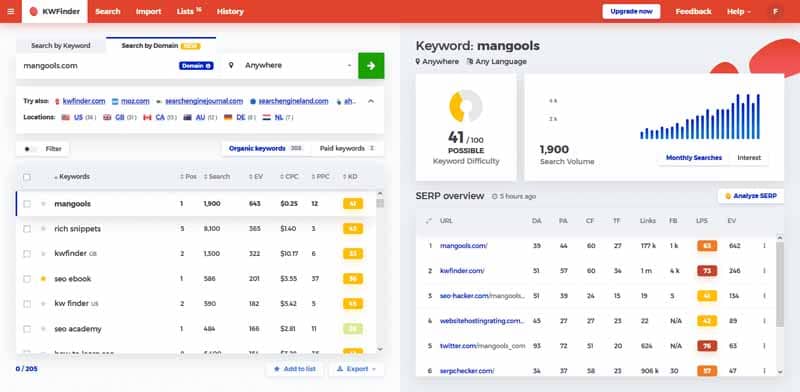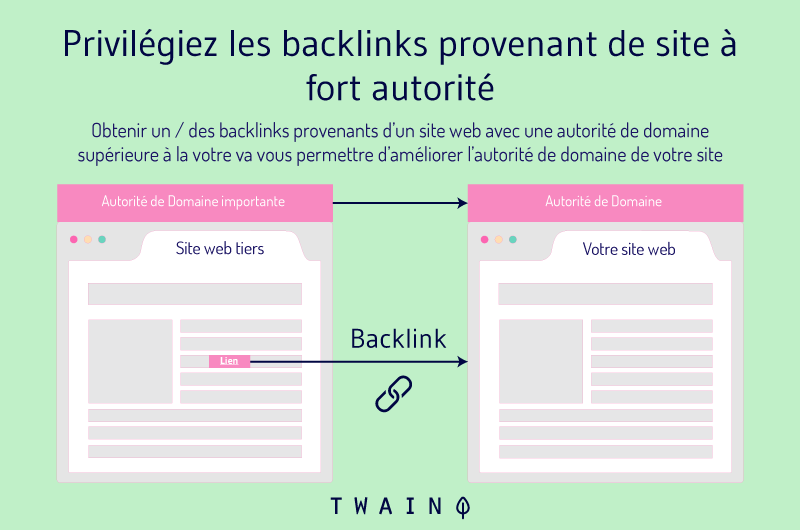Guest article by Kevin Bodin
You are a blogger, a website editor, a craftsman, a freelancer, an e-merchant? You have decided to launch your website in order to acquire qualified visitors ready to follow you and/or buy your products and services?
In the following article you will rediscover (and learn to master) an essential concept to ensure you get traffic from Google: The competition!

What is competitiveness on Google?
Just imagine! You create and publish your site, write your content and even pay a provider for your referencing.
Everything is done according to the rules and yet… days, weeks, even months go by… and your traffic still doesn’t take off…
After a quick audit, you realize that you do not appear in the first search results on the keywords of your theme. Only in the 2nd and 3rd pages where your competitors are positioned in the TOP 3 results of Google!

What can explain such a big difference? It is likely that it is a problem of competition.
Indeed, there is a direct relationship between your positioning on Google and the number of visits to your site
Here is an example of the percentage of traffic you could expect according to your position in the first results of Google:
- Position n°1: 32,5%
- Position n°2: 17.6% of the total
- Position n°3: 11,4% of the total number of visitors
- Position n°4: 8,1
- Position n°5: 6,1% of the total
- And so on..
Obviously, these percentages will fluctuate depending on your theme, the title of your articles, etc. ..
But one thing is sure, almost all the traffic is absorbed by positions 1, 2 and 3!
This means that if you position yourself on the second page, you will only get a few crumbs at best.
So, to avoid this kind of situation, read the following lines carefully. Especially since you will learn how to anticipate the competitiveness in the Google SERPs, bypass the overly competitive queries and position yourself in the first search results.
But before that… what is competition?

Competition is simply the ease to position yourself on the first page of Google (including the famous TOP 3)
This competition is generally based on 2 criteria
- The quantity and quality of your competitors’ referencing (backlinks)
- The volume and quality of your competitors’ content (semantics and lexical fields in particular)
Let’s take the example of a new locksmith in Paris wishing to position himself on “locksmith repair Paris 13”. It is likely that the competition on this type of research is extremely tough, for several reasons:
- The number of locksmiths in Paris
- The turnover of this activity
- The efforts and means in referencing used by these companies to position themselves on the first page!
In this case, it will be extremely difficult to compete with your competitors, if you are not ready to invest heavily in SEO (or to find less competitive queries on which to position yourself).
That’s how it is, there are themes where you have to fight!
On the contrary, let’s take an e-tailer specialized in laser collimators (yes, it’s really a product that exists…). The ability to be positioned on the first page (or even first position of Google) is much more obvious!
Why? For the simple reason that the number of e-traders present on the theme is less
You will need much less work (and investment) in SEO
to position yourself correctly.
You can even go further… by positioning yourself on an even more targeted keyword like for example :
- Best laser collimator
- Cheap collimator
- Buy collimator online
Of course, the number of monthly searches will be much lower, but :
- The competition will be too (even if it is not an exact science)
- The purchase intention (and therefore the conversion) will be more important

To summarize, the ability to position yourself well on Google depends essentially on the competition generated by the attractiveness of a query, a theme… and the level of referencing of the sites present on the first page.
But how to measure this famous competition before launching?
Very simple… you just need the right analysis tool!
The TOP 2 competition analysis tools
There are a lot of competition analysis software! For my part, I had the opportunity to work with 2 of them (with a big preference for the second one)
1 – Secockpit (from SwissMadeMarketing)
This versatile tool will allow you, from a keyword
- To know the number of monthly searches
- Discover similar/connected queries to your main keyword
- To analyze the competition for your keyword
To be “sure” to be able to position yourself easily on the 1st page of Google, make sure that your main keyword is at a maximum of 20 to 25% of competition!
2 – KWFinder (from Mangools)
The second software, which has become my favorite for a few months, is KWFinder for which you can find my full review here !
It has the same functionality as Secockpit, but in terms of quality/price ratio, I prefer it (with 10 days free trial)
Here is a video where I present you the tool:
For me, because of its features, it is the Swiss army knife that everyone who wants to launch a website to get traffic from Google should have!
Indeed, you will have access to :
- KWFinder : to analyze the search volume and competition for a keyword
- Serpchecker to analyze in more detail the first page of Google
- Linkminer to analyze the link profile of competitors (and get the same SEO spots)
If you have to use it, know that a low-competition theme is between a competitiveness index of 0 and 25 maximum
Attention, this does not mean that it is impossible to rank on the first page of Google on a keyword that displays 35 of competition… it’s just that it will be more difficult!

Source Kwfinder
But it is important to have this data in hand to know exactly what to expect and not to have bad surprises.
As for the pros and cons of KWFinder, the interface and the many search options are both great. You also have access to good customer service, which is nice for a value for money like this!
And to recap, here are the pros (but also the cons) of using KWFinder:
Advantages:
- Lightweight and fast – KWFinder loads keyword suggestions and information incredibly quickly! There is no latency
- Easy to use – This tool makes keyword research easy. It’s simple to use, regardless of your level of expertise. The intuitive interface ensures smooth navigation and keyword research.
- Various search engine optimization measures – KWFinder draws information from Moz, Majestic and some others. There is no need to subscribe to these services separately, as KWFinder already provides data.
- Allows multiple connections – You and your team can use KWFinder and other applications created by Mangools simultaneously, as long as you have the Premium or Agency plan
- It’s a web application, so you don’t have to install anything. You just need an Internet connection.
- Five tools in one – You not only get KWFinder, but also SERPChecker, LinkMiner, SiteProfiler and SERPWatcher.
- Free trial option limited to ten days
Drawbacks (because you need them):
- It doesn’t support multi-level keyword research.
- You can’t customize the SERPChecker preview.
- Your keyword results are limited. Keyword searches are limited, regardless of the package you purchase.
- Pricing plans are not for everyone (for the most expensive plans).
- Only two days money back guarantee.
Nevertheless, it remains a very good investment to analyze your theme in depth.
Now the question you are probably asking: Knowing the competition is good…but what happens next?
This is what we will see in the following article.
How to position yourself on the first page of Google? The basic rules!
To make it simple, once the competition has been analyzed you will have to set up an action plan to try to overtake your competitors on Google
To do this, you will have to :
- Get more and better backlinks
- Create a more qualitative and dense content
- Send good signals to Google (including a low bounce rate)
To do this, here is the strategy I use every time I want to launch a new site.
Step 1: Fill in your main keyword on Google and for each of your competitors present on the first page, you will have to analyze (still with KWFinder) :
- The number of words on the page/article to reference
- The quality of the semantic field (with 1.fr for example)
- The list of referring domains that link to the site and the page positioned.
Step 2: Depending on whether you have already written your content or not, you will have to either :
- Write longer content (but especially more qualitative)
- Improve your existing content (in length, but also in lexical field)
Notefor this second step, and from my experience, I noticed that the more a homepage was provided with quality content, the faster the site took off.
Step 3: After having listed the number and the different referencing spots of your competitors, the game will be :
- To try to put backlinks on the same spots as your competitors.
- To create more backlinks than your competitors on your site (of at least equivalent quality)
And for fun, here is a SEO strategy almost “turnkey”: Outreach
1 – Identify the content gaps in your industry.
The best way to generate content ideas is to look at what’s already doing very well in your industry. Look at your competitors’ sites: which pages, guides and blog posts are getting backlinks?

Think of ways to address that topic in more detail, or if there is an aspect or topic they have completely missed. This will give you the opportunity to create better quality content than your competitors and therefore inherently link-worthy.
2 – Create useful links.
Now that you know which topics have the potential to gain the most links, you need to create really good content around those ideas. Take content from your industry that has already gained a lot of links, and create your own by adding more value to it
That way, you know that blogs relevant to your industry will find your content compelling enough to warrant a link.
3 – List the sites to target.
Once you’ve created link-worthy content, you need to find people willing to link to it. Create a list of sites that could link to you, such as blogs for example
A good way to start is to look at which sites link to similar content from your competitors – these sites are likely to be interested in linking to your content.
4 – Contact the right people
You need to reach out to editors, webmasters and owners the right way – they are busy people, and your email needs to be clear
You need to be able to explain in a few lines why your content is worth citing. Otherwise, your email will probably end up in the trash, and so will your link.
Conclusion
As we have seen, the most important thing before launching any project is to start by analyzing the existing. The goal is to get a clear idea of the work to be done and not to launch blindly
Once you have all the elements in your possession, all you have to do is make the right choices and set up a strategy for the next 3 months



